Kostenloser Versand ab 30€ Bestellwert!
-
Shop
- Insights
-
Über ROMBO
- Händler
- Plektren-Finder
- Geschenkgutschein
+Kategorien
- accessories
- bass
- bass pick
- bass picks
- bass plectrum
- bass plectrums
- beginner
- bright tone
- chose guitar pick
- chose guitar picks
- chose plectrum
- chose plectrums
- CrystalBright
- Diamond
- Diamond pick
- discipline and guitar
- DIY generation
- durability pick
- durable pick
- eco
- ecoblack
- find guitar pick
- find plectrum
- fingers vs picks
- grip
- grip guitar pick
- guitar accessories
- guitar advantages
- guitar benefits
- guitar career
- guitar health
- guitar injury
- guitar learn
- guitar lesions
- guitar lesson
- guitar method
- guitar noise
- Guitar noise plectrum
- guitar pain
- guitar pick
- guitar pick beginner
- guitar pick bevel
- guitar pick buy
- Guitar pick diamond
- guitar pick durability
- guitar pick durable
- guitar pick eco
- guitar pick features
- guitar pick grip
- guitar pick material
- Guitar Pick Noise
- Guitar Pick online
- guitar pick recycled
- guitar pick recycled material
- guitar pick special features
- guitar pick textures
- guitar pick thickness
- guitar pick variable thickness
- guitar picks
- guitar tone
- guitar warm-up
- guitarpick
- guitarpicks
- hold a guitar pick
- hold guitar pick
- hold guitar picks
- hold pick
- hold plectrum
- hold plectrums
- how to
- how to chose your guitar picks
- jazziii
- learn guitar
- lose guitar pick
- material
- materials
- mental health and guitar
- motivation and guitar
- music
- not to lose guitar pick
- Online guitar
- online guitar pick
- online guitar pick buy
- pick
- pick durability
- pick material
- pick noise
- Picks
- picks vs. fingers
- play bass fingers
- play bass picks
- play bass with fingers
- play bass with pick
- play bass with picks
- play bass with plectrum
- play guitar faster
- plectrum
- plectrum attributes
- plectrum beginner
- plectrum bevel
- plectrum characteristics
- plectrum features
- plectrum grip
- plectrum material
- plectrum noise
- plectrum recycled
- plectrum shape
- plectrum variable thickness
- plectrums
- Plek
- pua
- recycled
- recycled guita pick material
- recycled guitar picks
- recycled picks
- recycled plectrum
- Rombo Diamond
- rombopicks
- tendonitis guitar
- the guitar pick
- tone
- variable thickness
- warm tone
- warm-up guitar

Medium Gauge Guitar Picks
Medium guitar picks are the most popular choice amongst guitarists and they offer the best of both worlds, right? Well, it is not that easy.

In our last article, “thin vs thick guitar picks”, we discussed both guitar pick thickness ranges in depth. Medium guitar picks deserve a separate analysis.
1- Why does guitar pick thickness matter?
Guitar pick thickness is usually measured in millimeters and this is an attribute that can change various aspects of a pick like flexibility, tone, volume, pick noise, durability, control over single notes, and more.

The thickness of a guitar pick is for this reason considered one of the 4 fundamental attributes of a guitar pick, along with guitar pick material, shape, and size.
2- Medium guitar pick thickness:
Medium guitar picks range in thicknesses from 0.55 and 1 mm.
The following is what a survey performed in March 2021 has shown. Thousands of guitarists were asked to define the following pick thicknesses:
- The maximum thickness of a thin guitar pick
- The minimum thickness of a thick guitar pick
With both limits established, we obtain the thickness definition of medium guitar picks.

The maximum thickness of a thin guitar pick was defined as about 0.55 mm by 2.292 guitarists.

The minimum thickness of a thick guitar pick was defined as 1 mm by 1.308 guitarists.
3- What is a medium guitar pick?
Medium guitar picks are guitar picks with a thickness between 0.55 and 1 mm. These guitar picks are very popular because of their versatility; in some areas, they offer the advantages of both thin and thick guitar picks.

Medium gauge picks have the broadest flexibility range. In this pick thickness interval, the material will play the most important role when it comes to defining the flexibility of a pick.
In other words, thick guitar picks are always stiff and rigid. With thicknesses over 1 mm, even the most flexible pick materials are stiff, and therefore the material has less influence on the flexibility of the pick. This relation creates a broad flexibility range amongst medium guitar picks, which can be very flexible or very stiff, depending on the material used.

The same effect can be applied to tone, durability, and pick noise.
Typically, medium guitar picks are used by lead guitarists who also implement rhythm guitar techniques and look not only for an all-round compromise between single-note melodic phrases and strumming, but also potentially developing a more versatile guitar career that integrates different techniques and mixes both worlds together.
4- Thin, medium and thick guitar picks:
|
|
Thin guitar picks (under 0.55 mm) |
Medium guitar picks (0.55 - 1 mm) |
Thick guitar picks (over 1 mm) |
|
Flexibility |
Flexible/very flexible |
Medium flexibility or stiff, depending on the material. |
Rigid/very rigid |
|
Tone |
Lighter tones, less bass |
Warm tones for softer materials. Brighter tones for harder materials. |
Warm/dark tones and mellow tones |
|
Volume |
Maximum volume is limited. Lower dynamic range. |
Can provide high volume with the usage of hard materials. |
Provide high volume. Broader dynamic range. |
|
Guitar pick noise |
Noticeable pick noise |
Reduced pick noise when the pick has a variable thickness. |
Reduced pick noise |
|
Durability |
Less durable |
Depending on the material. |
More durable |
|
Control |
Less control for single notes |
Very versatile. Control of single notes is possible if the player is experienced with this type of pick. |
High control of single notes |
|
Popular techniques |
Rhythm guitar, strumming, tremolo picking, ... |
Very versatile. A combination of both thin and thick guitar picks is possible if the player is experienced with this type of pick. |
Lead guitar, shredding, sweep picking, ... |
|
Common type of players |
Beginners, acoustic guitar players |
Most popular thickness. Medium thickness is used by beginners, intermediate and advanced guitarists. |
Intermediate and advanced guitarists |
This makes medium gauge guitar picks the most difficult picks to estimate without having tested them, and it is one of the reasons why we created the “guitar pick parameters” included in every product page, like in Rombo Origami.

5- Medium guitar picks are the best picks for beginners:
For most beginner guitar players, medium gauge guitar picks are the best option. You are in a process in which experimenting with sounds and learning new techniques will shape your profile as a guitarist in the future.
You might change your music taste during this process or even change your guitar type. You must stay flexible and versatile to allow your skills to develop in all directions and be a more rounded guitarist.
For this, a medium guitar pick is perfect, since you will be able to try different techniques with a pick that works very well in many different areas. After you have decided the direction of your development as a guitarist, increasing or decreasing the gauge won’t be that difficult.
Therefore, this is statistically the best option to start with if you want to try different guitar learning paths.

However, there are some exceptions: Some beginner guitarists know exactly what kind of player they want to be. They know from the very beginning if their dream is to become a very technical metal player, if they prefer being an expert acoustic guitar rhythm player, or if they will focus on songwriting and not on their guitar skills.
These examples are very rare, but they exist. In this case, you might want to consider starting with a guitar pick that has been designed for the type of skills you want to improve.
If you are a beginner, this might be interesting for you: Guitar pick for beginners
6- Medium guitar picks at Rombo
Rombo Origami guitar pick - 0.75 mm
Flexible but still rigid enough for note control. Right amount of flexibility for a snappy fluid attack that's bright and crisp. The concave surface on the hold area ensures ergonomic and comfortable hold.

Rombo Prisma guitar pick - 0.8 mm (available in September 2021)
A classic shape enhanced by modern surface technology. The geometry on the main body has different height levels for the most comfortable hold and grip.

Rombo Crisp guitar pick - 1 mm (available in September 2021)
Medium thickness combined with geometric concave design surfaces. The result? Unexpected flexibility with great bass tones. Its medium-sharp tip provides extra warm tones.

7- Conclusion on medium guitar picks
Each pick has a specific purpose, and you choose the pick based on the sound you want to achieve as well as other personal preferences like comfort and grip.
Medium picks are not just the picks in the middle of thick and thin guitar picks. They are a perfect approach for those guitarists looking to develop versatility and flexibility in their learning path.
Due to the high influence the material has on these picks, they are the most difficult picks to estimate before testing them, and every medium guitar pick is unique. Despite this, they are the best choice for most beginner guitarists.
However, if you have a very clear idea of the skills you want to develop in the future, you might be looking for either thin or thick guitar picks, which we discussed here.

7 Wege, um Plektrumgeräusche zu vermeiden
Plektrumgeräusche lassen sich nicht ganz vermeiden. Insbesondere bei der Aufnahme von Akustikgitarren neigen Plektren dazu, viele Klick- und Klackgeräusche und Geräusche zu erzeugen, die dein Spielerlebnis sowie das deiner Zuhörer ruinieren kann.
Beim Gitarre lernen, wirst du einen Punkt erreichen, an dem du dich auf die Übertragung von Emotionen, das wirkungsvolle Spielen und eine bessere dynamische Kontrolle konzentrieren möchtest.
Um Gitarrentechniken zu meistern, musst du jeden Ton, der von der Gitarre erzeugt wird, vollständig kontrollieren: beabsichtigte und unbeabsichtigte.

Ich persönlich denke, dass Plektrumgeräusche ein Teil des Gitarrenspiels sind, und ich genieße sogar einige Vintage-Aufnahmen, bei denen das Plektrumgeräusch fast absichtlich vorhanden zu sein scheint. In den meisten Fällen möchtest du es jedoch beseitigen.
Wir haben alle Tipps und Tricks zusammengefasst, von denen wir glauben, dass sie dir helfen können, die Geräusche beim Spielen mit einem Plektrum zu reduzieren.
1- Halte das Plektrum mit weniger Spannung
Gitarrenpicks erzeugen beim Zupfen/Anschlagen der Saiten Geräusche. Wenn du dein Plektrum lockerer hältst, hilft das sehr, da deine Finger einen Teil der Energie absorbieren, wenn das Plektrum auf die Saiten trifft.
Wir haben einen Artikel mit dem Titel „Wie man ein Gitarrenplektrum hält“ veröffentlicht, der alles enthält, was du wissen musst, um diesen Trick zu meistern.

Beim Aufnehmen kann es hilfreich sein, dein Instrument im Verhältnis zu den anderen etwas lauter zu machen. Dies ist eine in Studios übliche Methode, die den Gitarristen hilft, sich zu entspannen.
Egal, ob du eine Studio-Session, einen Jam mit deinen Freunden oder einige Solo-Relax-Sessions zu Hause planen, ein bewusstes Aufwärmen vor dem Gitarre spielen ist Pflichtprogramm.

2- Probieren verschiedene Winkel beim Anschlagen aus
Der Winkel des Plektrums im Verhältnis zu den Saiten ist das am meisten diskutierte Element, wenn es um Plektrumgeräusche geht.
Grundsätzlich gilt: Je weniger Plektrum mit den Gitarrensaiten in Kontakt kommt, desto weniger Lärm erzeugt es. Deshalb winkle das Plektrum leicht zu den Saiten an.
Probiere verschiedene Winkel beim Anschlagen und Zupfen aus. Dies erfordert eine bewusste Anpassung deinerseits, aber sobald du es gemeistert hast, kannst du den Anschlag des Picks leichter variieren.
Abhängig vom verwendeten Plektrum, dem Musikstil und den Gitarrentechniken, die du verwendest, und deinem Können, benötigst du einen anderen Anschlagwinkel. Konzentriere dich also 30 Minuten darauf, den besten für dich zu finden, und gewöhne dich daran, diesen zu spielen.
3- Ist deine Schlagkraft passend?
Manchmal spielt man und der Flow setzt ein, man verlässt gedanklich den Raum und betritt „die Zone“, diesen schönen Ort, an dem man besser klingt als sonst.
Wir gehen so sehr in die Musik hinein, dass wir natürlich härter zuschlagen.

Übermäßige Anschlagkraft ist eine der häufigsten Ursachen für Plektrumgeräusche. Darüber hinaus kann es das Sustain abwürgen und dazu führen, dass die von dir gespielten Noten auf viel weniger natürliche Weise ausklingen.
4- Nylon-Gitarrenpicks sind weniger laut
Das Material der Gitarren-Plektren beeinflusst nicht nur den Ton, sondern auch das Geräusch, das das Plektrum erzeugt.
Nylon gilt als eine der am wenigsten lauten Formeln, wenn es um industrielle Materialien geht, die für Gitarrenpicks verwendet werden.
Dies liegt an der Zähigkeit dieser Mischung, die dank ihrer mechanischen Eigenschaften starke Stöße effizient absorbieren kann.

Bei Rombo verwenden wir eine modifizierte Version von Nylon, die für zusätzliche Haltbarkeit sorgt und die Lebensdauer der Plektren verlängert. Dies war notwendig, da Gitarrenpicks aus Nylon sehr schnell verschleißen. Hier erfährst du mehr über die Materialien.
Wenn du dir nicht sicher bist, ob du das richtige Plektrum verwenden, ist ein Variety-Paket eine gute Option, das Gitarrenpicks mit unterschiedlichen Attributen enthält. Dies ist eine gute Möglichkeit, mehrere Picks zu testen und deine Entwicklung zu verfolgen, während du beginnst, deine Fähigkeiten für jedes einzelne Plektrum zu verbessern.
5- Die richtige Dicke des Plektrums
Als Faustregel kann man sagen, dass schwerere Plektren weniger laut sind, was irgendwie widersprüchlich klingt. Aber warum ist das so?

Die Verwendung sehr dünner Plektren in Kombination mit schnellem Spiel, wie Strumming, führt dazu, dass sich die Plektren verbiegen, wenn sie die Gitarrensaiten verlassen, wodurch eine Art Klickgeräusch entsteht. Dies geschieht besonders beim Spielen von Akustikgitarren, da der Korpus der Gitarre als Verstärker für diesen Klang fungiert.
Schwerere Plektren lassen jede Saite ihren eigenen Ton ohne viele Begleitgeräusche erzeugen.

Die variable Dicke, die in allen unseren Gitarrenplektren enthalten ist, verbessert nicht nur die Kontrolle, sondern reduziert auch das Rauschen. Der Körper des Plektrums ist dicker und steifer, während die Spitze dünner und flexibler ist. Mit diesem Merkmal wird die Gesamtflexibilität der Spitze verringert, während ihre ursprüngliche Dicke und ihr ursprüngliches Material beibehalten werden. Das bedeutet mehr Kontrolle und weniger Lärm.
Dicke vs. dünne Plektren. In diesem Artikel besprechen wir alle Aspekte, die einen Unterschied machen.
6- Eine abgeschrägte Kante kann helfen, das Pickgeräusch zu reduzieren
Plektren mit einer abgeschrägten Kante gleiten besser und verursachen weniger Geräusche. In Kombination mit dem bereits erwähnten Anschlagwinkel können sie dir dabei helfen, das Plektrumgeräusch stark zu reduzieren.
Auch die Form und Größe des Plektrums sind wichtig, aber das ist eher eine Frage der Präferenz.

7- Reduziere Plektrumgeräusche mit einem Plektrum mit polierter Spitze
Wir haben häufig darüber gesprochen, welchen Einfluss eine polierte Spitze auf den Ton und die Haltbarkeit eines Gitarrenpickels hat.
Eine polierte Spitze gleitet auch ganz leicht über den Rand der Gitarrensaite. Auf der anderen Seite erzeugen Gitarrenplektren mit einer raueren Textur an der Spitze eine stärkere Höhenwiedergabe, selbst wenn sie am Rand gespielt werden. Dies passiert auch, wenn die Picks beginnen, sich abzunutzen.

Einige puristische Gitarristen bevorzugen jedoch, wie am Anfang des Artikels erwähnt, das Plektrum sogar, um Geräusche zu erzeugen, und haben es extra in ihre Aufnahmen eingebaut.
Bonus: Nimm dich sich selbst auf
Sehr erfahrene Live-Spieler, die nicht viel Studioerfahrung haben, reflektieren manchmal nicht genug über all die kleinen Nuancen ihres Spiels.

Eine gute Übung, um dies zu vermeiden, ist sich selbst aufzunehmen. Es ist erstaunlich, wie viel wir verpassen, wenn wir in die Zone kommen. Du wirst beim Anhören deiner Tracks Plektrengeräusche bemerken und es ist viel einfacher, kritische Bereiche zu identifizieren, als während des Spielens.
Wenn du Akustikgitarre spielst, versuche, das/die Mikrofon(e) an verschiedenen Orten zu platzieren, du wirst feststellen, wie viel Unterschied es in Bezug auf das Plektrumgeräusch machen kann.
Abschluss
Wir können Plektrengeräusche nicht vollständig eliminieren, aber es gibt genug zu tun, um unser Spiel zu verbessern und es erheblich zu reduzieren.
Der beste Weg, Plektrumgeräusche zu reduzieren, besteht darin, sich dessen bewusst zu sein und über dein Spiel nachzudenken, um deine Fähigkeiten zu verbessern und verschiedene Plektren für verschiedene Stile und Gitarrentypen auszuprobieren.
Wenn du eine neue Möglichkeit entdeckst, den Plektrum-Lärm zu reduzieren, lass es uns bitte wissen, damit wir es in den Artikel aufnehmen können!

Guitar Pick Durability: Everything You Need To Know
The guitar pick has been in constant evolution since the 1920s.
Today, 100 years later, we have achieved great accomplishments in the area of durability of this very important piece of guitar gear.
In this article, we will review all the important points that can cause picks to wear out, and summarize all you need to know about guitar pick durability.
We will make some comments on the tone, to help control the changes, which happen after a guitar pick has worn down.
In addition, we will give some advice to keep your picks “healthier“, longer than expected.
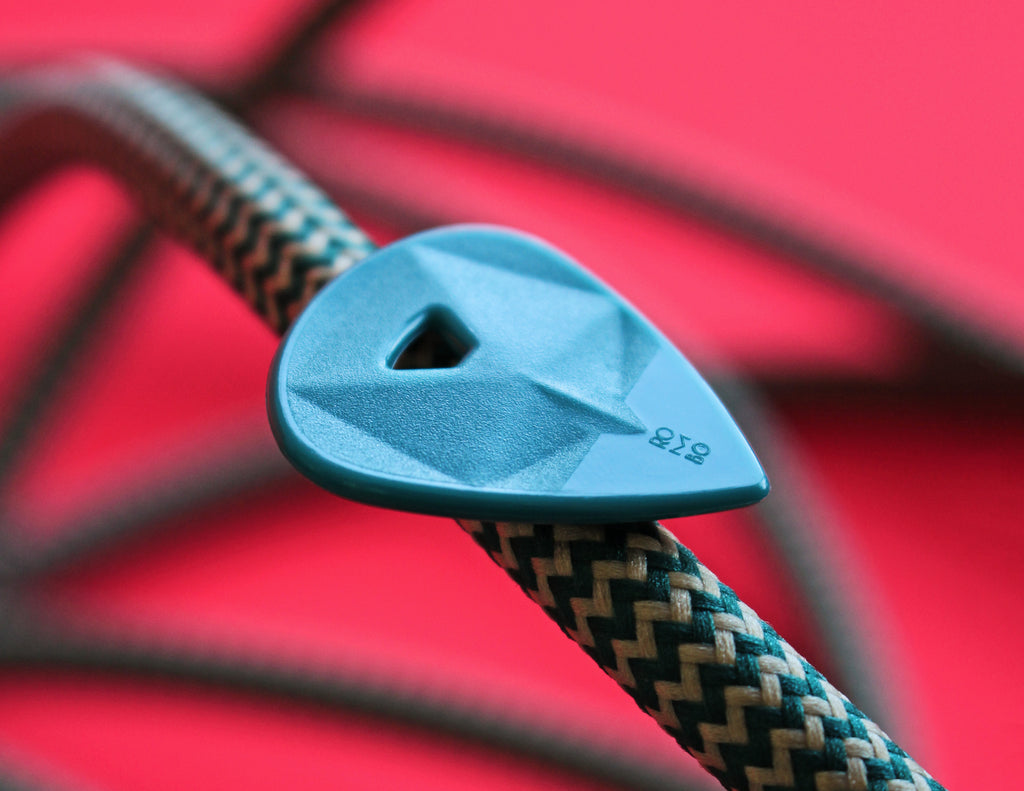
New vs. Old (worn down) Guitar Picks: Tone Changes
We all know that using different guitar picks, will also make a difference in your tone, and your playing. Material, shape, thickness and shape of the pick, directly affect the tone and playability.
Most standard plectrums can resist heavy strumming for a long time, without much wear and tear.
The first thing you may notice after using a guitar pick for some weeks, is that the tip is not as pointy as the new guitar pick. You will see it, and you will hear it, because the tone of the pick will change over time, with wear.


The rounded shape of the worn down plectrum, will create warmer tones, and feel darker. This is totally fine, if this is the tone you are looking for.
It will also affect the way your plectrum plucks the strings:

Just like the guitar strings, the frets, & other components, the guitar picks will wear out over time.
Some players feel a lack of control after the guitar pick has worn down, while others use the rounder picks because of the tone they produce. This especially happens to jazz guitarists, who tend to choose picks that are almost circular, for example: Rombo Waves.
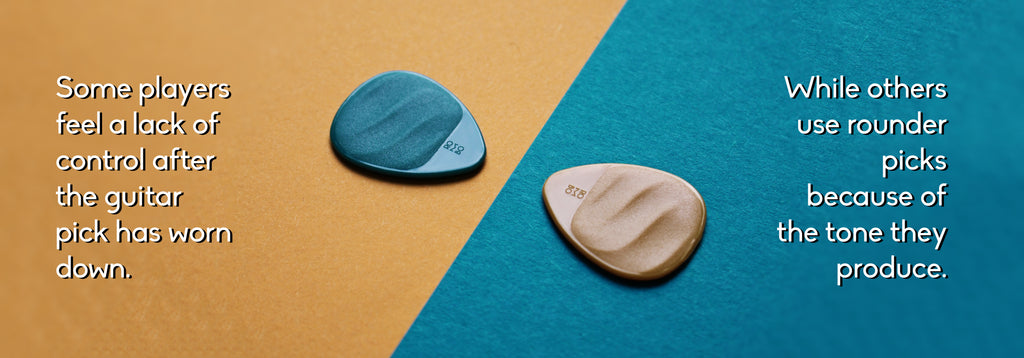
Gaining control when using rounder guitar picks, is an ability you can train yourself to do, and improve.
Why Can’t Picks Last Forever?
Guitar strings are usually made from a mix of steel, nickel, bronze, or brass. In other words: Metals.
Since most players use some kind of plastic material for their guitar picks, (nylon, delrin, …), it’s not surprising that friction between strings and picks will cause the guitar picks to wear down.
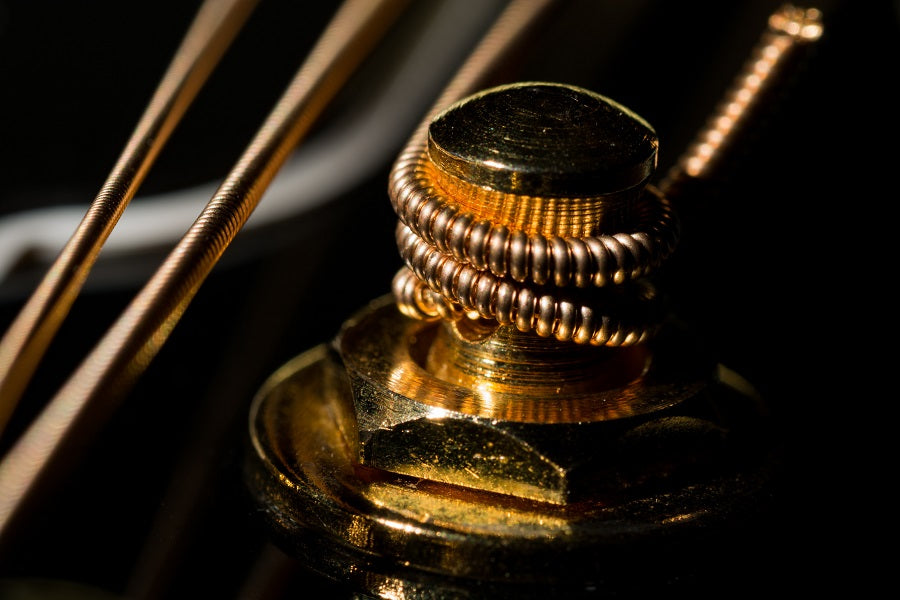
You will notice, the thickest guitar strings have a spiral wire wrapped-around, acting like a sanding file on the plectrum.
Guitar Pick Durability: How Long Should a Guitar Pick Last?
The short answer: If you are an average user, your picks should last a few weeks to a month. If you are a professional player, using specific techniques, like heavy picking and strumming, it will probably last just one day, especially if you are a studio musician recording new tracks every day.
The long answer: This answer includes many factors including guitar pick attributes, and external factors, regardless of the guitar pick you are using. We discuss all of them below.
Guitar Pick Attributes That Directly Affect the Durability
The attributes that define the durability of a guitar pick are as follows:
- Guitar Pick Material
- Guitar Pick Thickness
- Guitar Pick Tip Shape
- Guitar Pick Tip Texture
Harder materials will wear down slower. This is one of the reasons there has been a lot of research in the area of suitable materials for guitar picks.
The goal is to find a wear-resistant material, that keeps the tone characteristics that guitar players want, while still giving a good grip.
However, material is not all. The thickness of a guitar pick will enormously affect the wear and tear. Thinner picks will wear down almost immediately when using heavy pick techniques.

Other attributes of the pick that affect the durability, are the Tip Shape, and the Tip Texture. Very pointed guitar tips tend to wear down faster, because there is less material on the tip.
However, this problem can be partially solved with the right guitar pick tip texture. A polished tip on the guitar pick will cause less friction between strings and plectrum. This is one of the most underrated attributes of a guitar pick, and you can find more information HERE.
What Damages the Pick the Most?
Results show, that the best way of altering and degrading the shape of your plectrums is to perform “pick slides”.
This guitar technique will wear away the edges of your plectrum and will make it useless very quickly.
This won’t directly affect the tone or control of the plectrum, but the damaged sides will contain some dents. The plectrum will get stuck either on the up stroke or the down stroke.
External Factors Which Indirectly Affect the Durability
It’s not only the guitar pick quality that is responsible for its‘ damage. There are three more factors that can play a role on the durability:
- Hours of guitar training
- Guitar strings gauge
- Guitar playing style and used techniques
It is a very simple equation: The more hours you practice, the more your picks will get damaged.
Thicker guitar strings will increase the area of contact with your plectrum, and therefore, wear it down much faster.
Aggressive guitar playing techniques, like fast palm mute, or pick slides, will damage your guitar pick very easily.

How to know if a Pick is Durable?
The best way to find out, is to test it, and make your own judgment.
You can take advice of expert players, who have tested lots of guitar picks. However, if their playing styles differ from yours, this information won’t help much.
Besides, many expert players have not changed their picks for decades, and they might be missing the material improvements of the last decade.
As mentioned, not only is durability a factor to take into account when choosing a guitar pick, but also the tone and the ergonomics (grip, size,...).
How to Know When to Replace Your Pick?
If the edges of your pick are becoming more rounded, you might start to consider purchasing a new one.
However, never throw away your worn-down guitar picks! The rounded edges can be used to create more mellow tones, and you might want these for some of your songs.
One of the most important things about playing the guitar, is to keep your mind open to new tones and styles. This is the reason some guitar picks have rounded tips even when they are new.
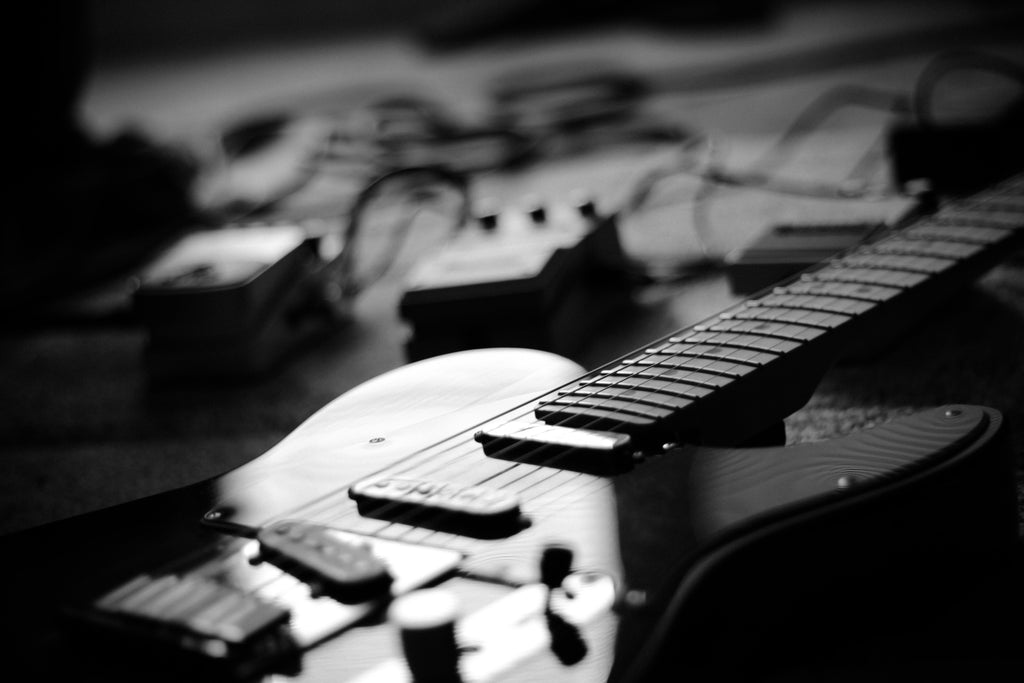
In addition, you can store your old guitar picks in a box. I wish I still had my first guitar pick, that I used, when I was learned to play guitar as a child. A guitar pick can be a beautiful piece of your past.
Check Your Pick Condition Regularly
A tip from my side, is to double check every guitar pick before going out on stage, or studio. A visual inspection is fine.
Always keep some unused plectrums aside. Considering plectrums are probably the least expensive gear of your complete guitar rig, constant wear and tear issues is not a thing you should worry about.
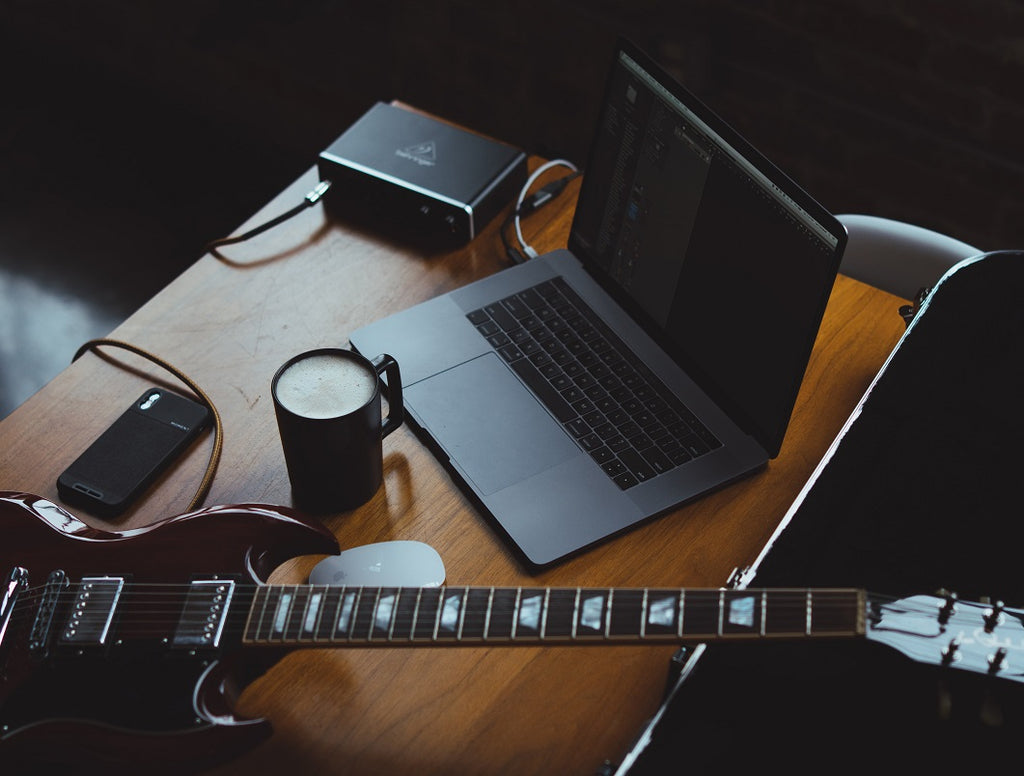
Choose your ideal Plectrum
Are you using the right pick? This is a question you should ask yourself every time you play a song.
Some players have their 5-favourites, depending on the style and type of guitar they want to play.
The most important factors when choosing the right plectrum for you hinges on….
- Material
- Shape
- Thickness
- Size
- Playing style
- Your personal preference
We created a guide that will help you find the right plectrum for you.
You can find it HERE.
Thank you!
The support we are getting from the guitar community makes us very happy!
We, (Carlos and Judith), are really doing our best to create the best guitar picks for you.
If you consider supporting a small family start-up, you can share this article and directly have an influence on our online visibility.
These small actions have helped us since January 2019, and we count on your support! :)

Thanks!

The Guitar Pick: Bevel, Tip and Shape
The guitar pick tip is the pointy bit on the end of your plectrum. The tip and its shape is probably the most important area of a guitar pick.
The pick tip can be rounded or pointy, and if the plectrum is thick enough, a beveled edge can be included to increase the speed and control.
Depending on the shape of the tip, the guitar pick will be suitable for specific techniques.
-
Sharper tips are very good for speed and tremolo playing.
They are better for fast lead lines. - Rounder tips are usually more adequate for strumming chords. They will produce mellower sounds.

Why a beveled edge matters:
The bevel of the pick impacts the attack.
The bevel creates a surface for the strings to glide off on, and with the design of the bevel, you can adjust the degree to which the pick grips the strings.
A well-designed bevel is usually preferred by most players due to the following benefits it provides:
- Increased speed
- Improved control
- Better tone
Put simply, it makes playing easier. Additionally, it will impact the attack your plectrum provides.
Tip: Other attributes such as polished guitar tips can also help you improve your guitar playing. Learn more here.
Attack of a guitar pick - Pros and Cons:
The guitar pick tone is strictly related to its attack. Being able to hear the different nuances of a heavy and light attack plectrum is essential for becoming a great guitarist.

Heavy pick attack - Benefits:
Using a heavier pick attack will allow you to change your tone without losing tone clarity and brightness.
If you dig in with your pick, your tone will distort. You will create a crunchier sound without the need for guitar pedals. This happens because the guitar strings vibrate in a different way when using a heavier pick attack. Nevertheless, the notes will remain well defined.
This is especially important for jazz and blues players, where the clarity of individual notes plays an important role.
Heavy pick attack - Drawbacks:
Guitar picks with a very heavy attack can reduce the sustain of your guitar tone. Applying too much pressure to the strings can choke your guitar.
Furthermore, the strings will suffer much more because of each impact. This will subsequently reduce the lifetime of your strings.
Finding the balance:
Using heavier gauges of guitar strings (0.12 or more) can be a solution to the aforementioned problem. This allows you to use very heavy pick attacks without compromising sustain and tone.
Therefore, my personal recommendation is to increase the gauge of the guitar strings for sharp guitar pick usage.
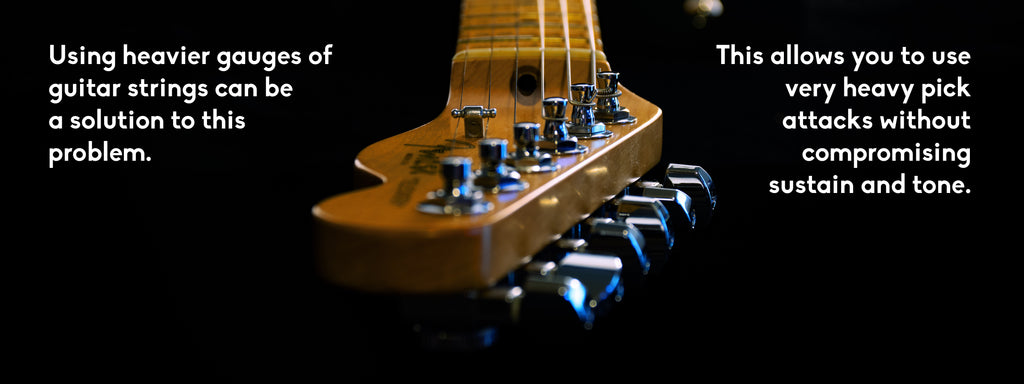
Note: There are many annoying things in life, but there’s nothing more annoying than losing a guitar pick you just had in your hand, and then realize that it has disappeared forever! - 4 Tips To Not Lose Your Guitar Picks
Managing the guitar pick attack: Practical exercise
In order to see the difference in action follow these steps:
- Crank the amp to the edge of distortion.
- Exaggerate “gentle” playing (as lightly as possible).
- Pay attention to the sound and tone.
- Exaggerate “hard” playing (as heavily as possible).
- Pay attention to the sound differences.
- Repeat the exercise for different volume settings.
Finally, reflect on which settings are most appropriate for you. Decide on a point between “very gentle playing” and “very hard playing” that you feel comfortable with.
Knowing this difference will help you define your own tone. Understanding the basics of the attack of a guitar pick can be very useful when creating a versatile guitar playing style.
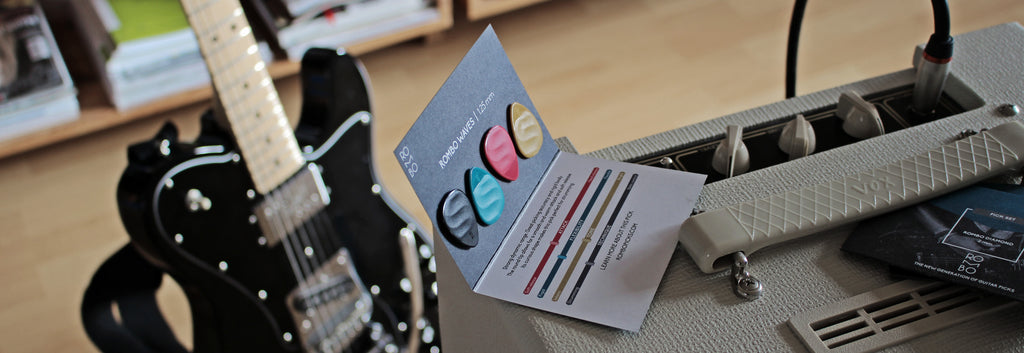
Mixing both techniques during lead parts is very effective when creating dynamic tones, sequences and highlighting specific parts of your playing. You can change the subjective feel of your playing and develop a sense of tension and emotion.
Tip: You can control the volume amp settings and also the guitar volume/tone settings. It might take longer to finish the exercise, but you will be surprised at how all these parameters work together!
Attack, tone, technique, and flexibility:
We started from the very beginning and went back to the roots, back to the meaning and the definition of a guitar pick. As a result of the study of the physical properties, we defined four parameters to precisely describe a plectrum: attack, flexibility, tone and technique.

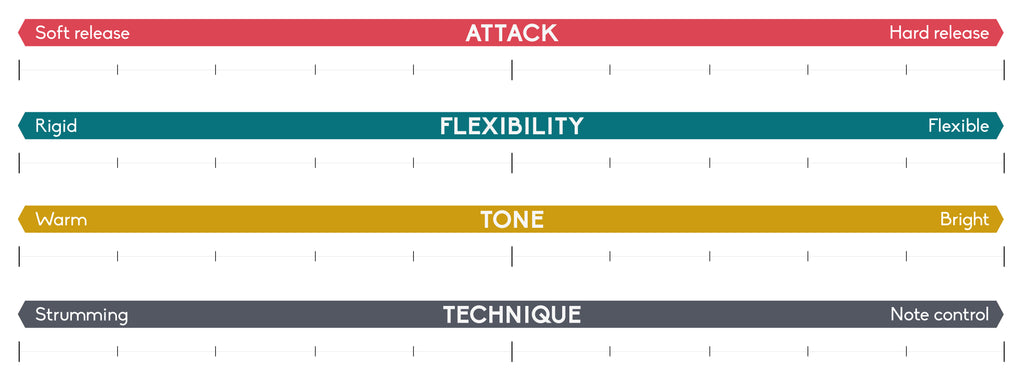
Changing the form, dimensions and material, we can directly influence such parameters. These attributes are strictly interconnected.
Example of a guitar pick with a very high attack:
Rombo Diamond:
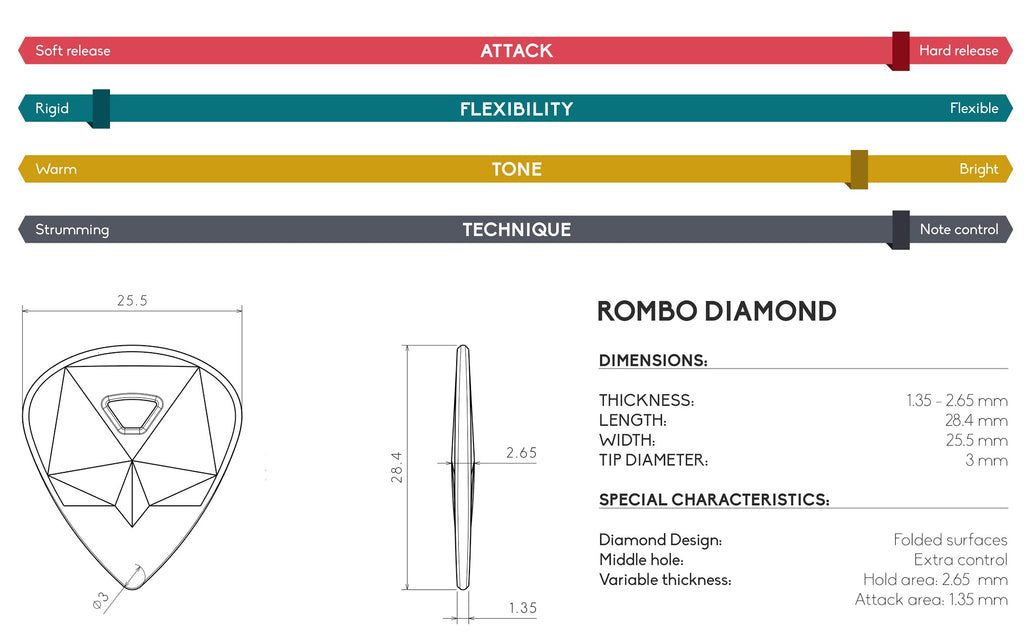
Exceptional picking control and accuracy. Favorite amongst advanced guitarists. The hole in the middle provides an extra control and grip rate. Sharp tip for high attack, and a clean bright tone.
As you can see, a very small diameter of only 3mm, combined with low flexibility make the attack of this pick very heavy.
Learn more here.

Example of a guitar pick with soft release (less attack):
Rombo Waves:

Strong dynamic range. Great picking accuracy and rigid body. The round tip allows for a smooth and warm attack and soft release. Its curious shape makes this pick perfect for strumming.
A very rounded tip and less thickness to increase flexibility make this pick perfect for mellow tones and soft release
Learn more here.

Conclusion:
Depending on your needs, you might prefer using sharper or rounder guitar picks.
The best players are able to use the best of both areas and create their own style.
Understanding the relation between guitar pick shape and attack is essential when mastering guitar techniques.
What about the material?
How can the guitar pick material influence your sound?
Learn more here.
Folge uns
Judith Heindorf & Carlos Diez Macia GbR
Auf der Steige 29
71686 Remseck am Neckar
DEUTSCHLAND
- Shop
- Händler
- Impressum
- AGB
- Widerrufsrecht
- Versandbedingungen
- Datenschutzerklärung
- Kontakt
- Presse
- Fragen & Antworten
Melde dich zu unserem Newsletter an und erhalte alle Neuigkeiten zu Sales, Neuerscheinungen und vielem mehr…
Mit der Anmeldung stimmst du unseren Datenschutzbedingungen zu.
© 2024 ROMBO.
ist eine registrierte EU-Marke.
Wir nutzen Shopify.


